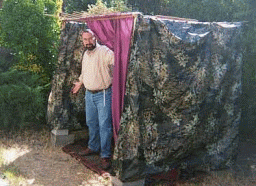here’s what I wrote in a recent column…
Screaming in the dark
2/14/03
By Neal Ross
If you live among human beings, you must never mention how terribly, nakedly vulnerable we all are ? because we all spend a good deal of our lives trying to pretend we?re not.
I don?t know why that is; I suspect it?s related to our biosurvival imperative, which tries to keep us going against all odds. Intense pain is one of those odds: we humans like to build little consensual hallucinations to overlay and influence our perceptions, and intense pain ? physical, spiritual, or emotional ? shatters our careful efforts like a child?s foot through a sandcastle.
Since Dec. 27, I?ve discovered that the most profound and interesting of these pains is known as “deep grief.” On that day, Jim “Sputnik” Gjerde, my lifelong best friend (read: “psychic twin and other half”), died after spending two weeks in a coma brought on by a genetic-diabetes-related heart attack. And since then, I?ve been sifting sand and wondering what happened.
(I rarely read columns written about best friends who have just died, and writing this I realize why: If you didn?t know the person, or experience first-hand a similar loss, it won?t mean anything to you. But as death is the price of life, so is grief the price of love ? and we will all eventually experience at least one of these, in some flavor or another.)
“Deep grief” is the term used by my counselor at the Valley of the Moon Hospice Team (935-7504 ? a hard, but important, phone call), who is helping me cope with this first (for me) major loss. Deep grief (or what I?ve been calling “The Gray Sameness”) is when you don?t feel like eating, or sleeping, or working, or playing, or really doing much of anything except gazing blankly into the middle-distance, howling like an animal, and trying to melt into whatever surface is currently holding you up.
It hurts. A lot. More than can be imagined beforehand. But it also feels like an initiation into an exclusive but universal club. And therein lies The Mystery: “It cannot be borne, and yet it must.”
Generally speaking, I enjoy ungraspable mysteries ? I like the fact that the universe is bigger than my head; that some things can only be experienced, not explained. Grief is like that, but amid the rust and ashes there are glimmers of light ? definitely present though not always seen. And that?s exactly as it should be, at least for now.
A longtime friend called the other day to check on me. When he told me that his brother had died five years ago, I stopped in mid-mumble. “You know,” I said.
“Yes, I know,” he replied.
“So I don?t have to explain anything to you,” I said.
“Not one bit,” he said.
He then told me about the day, some time after his brother?s death, when he looked up and realized that he had just had a good hour. Sometime after that, the good time expanded to two hours. Then, eventually, a half-day. Then a whole day, two, a week. And so forth. The pain never left, but it did become manageable.
My friend then apologized for sounding superficial, and I told him there was no need: “You?re someone who?s traveled further down a path I?m currently walking, and telling me what it looks like. So thank you ? because right now, I have no idea how to even get to that first good minute.”
At this writing, I still don?t. But at least I know it?s coming ? and I hope to recognize it when it arrives.

